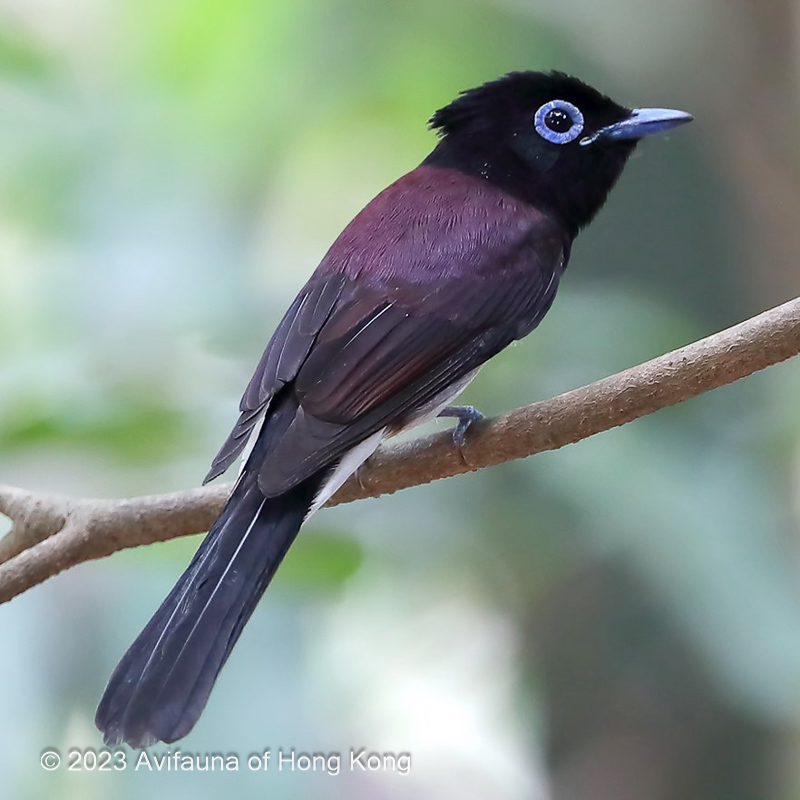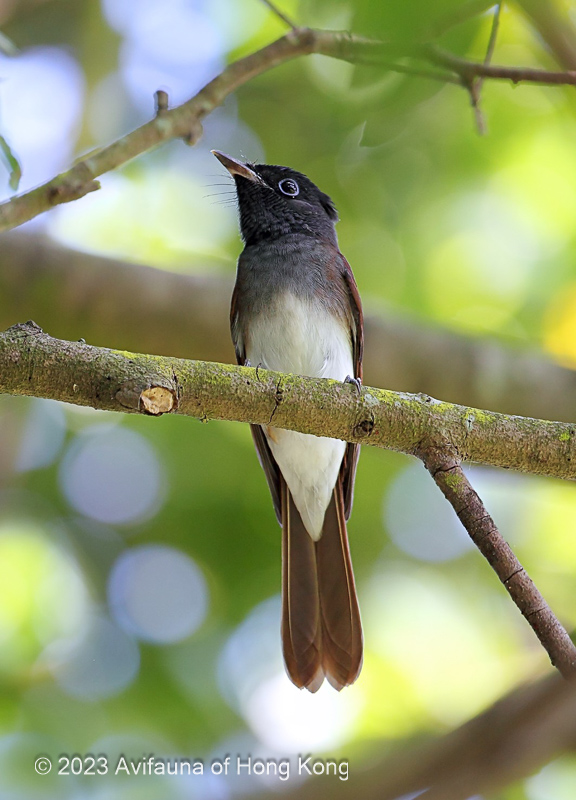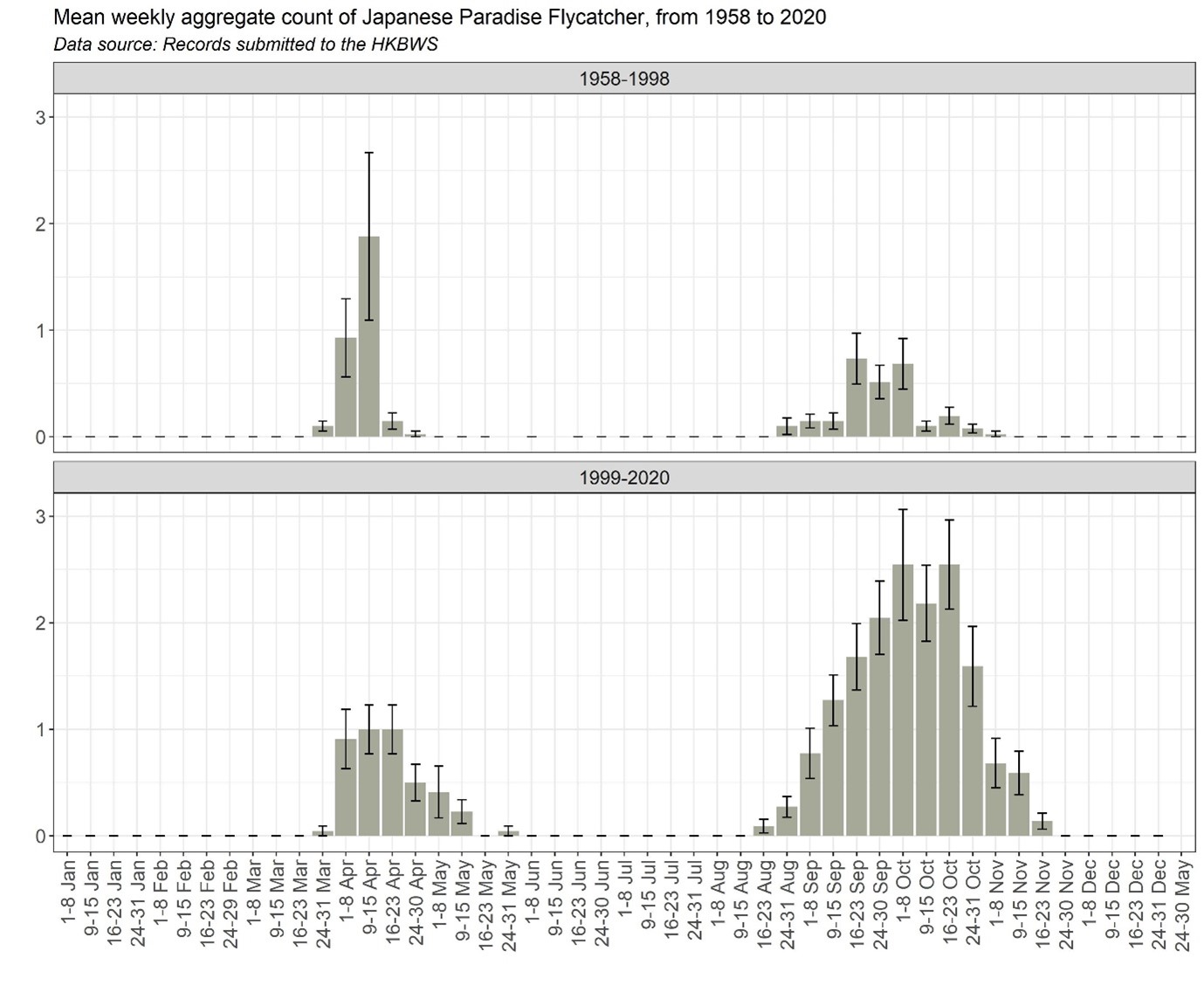Japanese Paradise Flycatcher Terpsiphone atrocaudata 紫綬帶
Category I. An uncommon spring and autumn passage migrant to closed-canopy woodland in variable numbers.
IDENTIFICATION

Apr. 2014, Michelle and Peter Wong.
18·5–20 cm. Adult male has black head, crest, throat and breast and purplish upperparts and tail. Belly and vent are white. It has a broad blue eye-ring and a blue bill. In breeding plumage, the central tail feathers are very long and extend up to 25 cm beyond the rest of the tail.

Apr. 2012, Michelle and Peter Wong.
The female (17–18 cm) is smaller than the male. The head, crest, throat and breast are dull purple-black. The breast is clearly divided from the white belly and vent. The mantle is dark rufous brown, sometimes with a purple wash. The tail is brown. The rump is often rufous, contrasting with the darker mantle and tail. It has a blue eye-ring and a blue bill.

Sep. 2011, Michelle and Peter Wong.
First-winter birds have a thin blue-grey eye ring and a greyish bill with a pale base. They are distinguished from female/first-winter Amur Paradise Flycatchers by dull rather than glossy head, less bright mantle, uniform sooty primary coverts, tail often contrasting with a rufous rump, no clearly-defined demarcation between throat and breast but a more clear-cut border between breast and belly, often in the shape of an inverted U.
VOCALISATIONS
The call of Japanese Paradise Flycatcher is a double- or triple-note sound similar to Amur Paradise Flycatcher but flatter, harsher and more even in pitch across all elements.
DISTRIBUTION & HABITAT PREFERENCE
Widespread in suitable wooded habitats. Many records are from mature closed-canopy forests on the Tai Mo Shan massif, but there are also regular reports from migration sites such as Mai Po, Po Toi and Ho Man Tin.
OCCURRENCE
Japanese Paradise Flycatcher is an uncommon passage migrant in variable numbers that has occurred between 28 March and 31 May in spring, and between 20 August and 18 November in autumn.
Numbers recorded on spring passage have reduced since the period up to the end of the 1990s, when 55% of all records occurred in April (Figure 1). Only 24% of all records from 1999 to 2020 have occurred in spring and there were no sightings at all in 2001 and 2018. Welch et al. (2016) first highlighted this trend and noted it occurred against a background of increasing observer activity on offshore islands where this species is regularly seen.
In total, there have been five records during the last week of March, but only one of these occurred in the period 1999 – 2020. Main passage takes place during the first three weeks of April. Small numbers occur during the first two weeks of May, after when it is rare. Males in breeding plumage are regularly seen at this time of year.
In autumn, there are occasional records during the last two weeks of August and in early September, but main passage is from the third week of September to the third week of October. Passage tails off in November and there are no confirmed records after the 19th (Figure 1).
Most records involve single birds. The highest single-site count on record is six at Tai Po Kau on 13 April 1992.
From 1999 to 2005, total annual counts were in single digits, but counts since 2006 have all been in double digits. The highest yearly count was 33 in 2016. This rise in numbers is almost certainly due to an increase in observer activity.
Swinhoe (1861) collected a male during his stay in HK in 1860. The next reports were nearly a century later and concerned two at Pok Fu Lam on 21 April 1953 (Dove and Goodhart 1955) and two at Victoria Peak on 1 October 1957 (Walker 1958).
BEHAVIOUR, FORAGING & DIET
Feeds on insects. Often seen singly but sometimes joins mixed foraging flocks in woodland. Very active. Regularly hawks flying insects from a perch.
RANGE & SYSTEMATICS
The nominate form breeds in Korea and Japan and migrates through south China and Indochina to winter in the Malay Peninsula and Sumatra. T. a. periophthalmica breeds on Lanyu Island (off Taiwan) and Batan Island. (north Philippines), and winters in the north and west Philippines. T. a. illex breeds on the Ryukyu Islands but its wintering area is unknown (Moeliker 2020, Cheng 1987).
CONSERVATION STATUS
IUCN: Least Concern. Population trend stable.
Figure 1.

Cheng, T. H. (1987). A Synopsis of the Avifauna of China. Science Press, Beijing.
Dove, R. S., and Goodhart, H. J. (1955). Field Observations from the Colony of Hong Kong. Ibis 97: 311-340.
Moeliker, K. (2020). Japanese Paradise-Flycatcher (Terpsiphone atrocaudata), version 1.0. In Birds of the World (J. del Hoyo, A. Elliott, J. Sargatal, D. A. Christie, and E. de Juana, Editors). Cornell Lab of Ornithology, Ithaca, NY, USA. https://doi.org/10.2173/bow.japfly1.01
Swinhoe, R. (1861). Notes on the ornithology of Hong Kong, Macao and Canton, made during the latter end of February, March, April, and the beginning of May 1860. Ibis 1861: 23-57.
Walker, F. J. (1958). Field Observations on birds in the Colony of Hong Kong. Hong Kong Bird Watching Society, Hong Kong. (duplicated).
Welch, G., J. Allcock and R. Lewthwaite (2016). Declines in some Hong Kong land bird species: 1990-2014. Hong Kong Bird Report 2014: 340-358.

